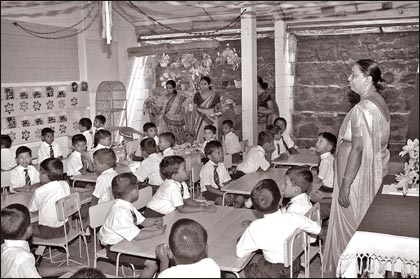Targeting literacy among children
Literacy is the capacity that separates human beings from every other
being. The work literacy is one word with eight letters. Without
literacy those letters would be meaningless symbols.
Today literacy has become the driving force in early childhood
language arts instruction. Even though the word is used constantly,
there are probably as many definitions for the word as there are
references to it. An easy word but a most difficult concept.
Development of a child and the development of people in a country at
large are tied to literacy. Historically, literacy has meant the ability
to read and write - three Rís reading, writing and arithmetic.
Now with all we have learned about how children develop language, how
learning takes place and how to teach more effectively the definition of
literacy has broadened.
|

Primary school teachers have a major role to play in Literacy
development of children. File photo |
In advanced countries the rate of development is measured to a
certain extent on the literacy rate of its people. It is believed that
literacy is the ability to make effective use of basic communication
operations. These communication operations generally include efficient
a) Reception and b) Expression of language.
Literate people are able to enjoy literature, art, music and drama.
Literate people can think and communicate with. Others about life and
their experiences. Literacy is the essence of human interaction.
Literacy development is an ongoing process and should be viewed as a
process of discovery and not as a collection of skills that are in
isolation.
Literacy instruction should be seen as a way to help children
experience life, language and print to understand the relationships
among those elements and to become effective communicators. Literacy
instruction is a way to expand the natural language and experiences of
children.
It is a way to help children to develop communication skills.
Literacy instruction is a demanding task but one that is most rewarding
for the teacher. Both learning and teaching literacy to children can be
fun. A wide variety of activities using several materials and methods
have to be used to provide children with many experiences in listening,
speaking, reading and writing that are fully integrated for continual
development.
In this regard teachers in primary schools have an immense task on
their shoulders.
Planning the appropriate activities and providing the necessary
environment for developing literacy is the key to develop the ability to
communicate.
In a pre-school the word used and the words children know are
invariably spoken. He or she may know a few written words but there is
little knowledge of abstract words like Ďforgivenessí because they are
not easily visualized and is a difficult concept to grasp. A lot of talk
is colloquial copied from adults and other children. The imitative
element is predominant.
The learning process of children is an information-processing unit,
something similar to what we experience in computer technology.
Learning will focus on 3 main areas
1. Input. - Presentation and the selection of Information which
enters through the sense organs coded and passed on to the brain where
it can be stored for a short time-short term memory.
When the Input has meaning it becomes
Long Term Memory.
2. Processing - The internal operations leading to creation of
meaning.
3. Output - External practice to establish new information in Long
Term Memory.
Input can include:
a) Incidental learning
b) Unguided Learning Placing a child in a particular environment will
guide her learning - Maria Montessori
c) Directed Learning - Social Training using selected experiences.
Eg: We donít play rough.
For instance, preschool learning involves pictures and mental images
and play in real life and imaginative play for language growth.
This article was
extracted from a study on Literacy among Children and written by Ruth
Rani Silva, a retired teacher who taught both in the primary level and
secondary level in Sri Lanka and abroad for over 35 years. |



